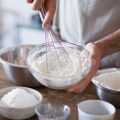Struggling to achieve the perfect sourdough starter temperature for your baking needs? Well take a look at this short but helpful beginner’s guide, to get you started and on your merry way!
![Sourdough Starter Temperature [Beginner'S Guide] 1 Sourdough starter temperature [a beginner’s guide]](https://www.mydailysourdoughbread.com/wp-content/uploads/2023/01/blog-images-58-720x405.jpg)
Table of Contents
- Best Temperature For Making Sourdough Bread
- How To Keep Your Sourdough Starter Warm
- Making A Sourdough Starter When It’s Hot
- Baking Sourdough Bread In Colder Temperatures
- Sourdough Starter Temperature
- FAQs
Best Temperature For Making Sourdough Bread
Sourdough fermentation typically occurs at temperatures between 75°F-82°F or 24°C-28°C.
However, this doesn’t mean that fermentation will not occur outside of these temperatures.
Once you familiarize yourselves with the ambient temperature in your home, it will help you bake the best sourdough bread no matter the weather.
An increase or decrease in humidity can drastically affect the way your sourdough bread will behave.
Temperature Guide For Sourdough Starter
While temperature can affect your bread dough, it will certainly affect your sourdough starter. Creating a sourdough starter can be difficult, especially if the temperature in your home doesn’t comply with the sourdough’s needs.
How To Keep Your Sourdough Starter Warm
In order for your starter to survive, you need to ensure that it is kept warm, but not extremely warm enough to kill it. Sourdough starters can die from overheating, so if a certain spot is feeling a little too warm for you, then it’s likely too hot for the starter.
Here are some ways to effectively trap heat and bake a successful sourdough bread.
Find The Warmest Spot In The House
Most of us have a hidden gem in the house that emanates the most warmth consistently. For instance, the top of the fridge, near an internet router, or a coffee machine. If you were to place your sourdough starter near this heated item, the heat will keep the starter nice and warm throughout, though the starter can grow quickly, so make sure you keep an eye on it!
Try Your Oven
Another great way to keep your starter warm is to place it in the oven, with the oven light on. This will give a good temperature, and as long as the temperature doesn’t reach 122F it should be good for your sourdough baking. Additionally, you could place the starter in a Dutch oven and place that into the lit oven.
If you have a thermometer that measures air temperature, then use it to measure the exact temperature of the oven, with the light on so you can get a general idea of what you’re working with.
Use a Dutch Oven
If your oven is too warm for your starter even with just the oven light on, then place your starter in the Dutch oven or a cast iron pot, and make sure to cover it with a lid. This will prevent the heat from escaping, whilst your starter remains warm and cozy.
Warm Water
While warm water eventually becomes cold, it’s good for a little sourdough boost. Use it when feeding your starter, and even throughout the sourdough bread recipe. This is especially great if you’re trying to speed up the rise.
Use An Electric Blanket
This is a great little trick for sourdough bakers. If you have an electric blanket, simply pop it on the lowest setting, and slide your jar of starter beneath the blanket to keep it warm.
Making A Sourdough Starter When It’s Hot
If you’re living in a very warm area, then you may have noticed your starter becoming active very quickly, thus eating all of its food quickly.
Here are some things that you can do to ensure your starter develops at a steady pace:
- Keep your starter in the coolest part of the house., i.e., cool tiled floors
- Feed your starter at a higher ratio, so instead of 1:1:1, you could try 1:2:2. However, if your starter becomes too foamy or runny try feeding it 1:2:1.
- Slow down your starter by using icy cold water.
- Store your starter in the fridge once established.
Baking Sourdough Bread In Colder Temperatures
While warmer temperatures can assist with fermentation, colder temperatures tend to make it harder for the dough to ferment. In these circumstances, you may need to find ways to help your dough before you can bake sourdough bread.
Here are some tips for you to try:
- Double the amount of starter you use, as the more starter you use the quicker the dough will ferment.
- Use warm water when mixing the dough.
- Use a proofing box to bulk ferment your dough. This will ensure the dough remains at the right temperature, throughout the entire bulk fermentation process.
Sourdough Starter Temperature
Making sourdough bread in hot or cold conditions certainly comes with its own challenges. But with the right equipment and guidance, you should be able to bake bread in no time!
Speaking of beginner, I have an easy beginners sourdough guide and a beginner’s sourdough recipe you might wanna try!
FAQs
What Temperature Is Too Cold For Sourdough Starter?
Temperatures below 68F are considered too cold for a sourdough starter, which is why it’s best to find a warm spot to place your starter.
Is 30 Degrees Too Hot For Sourdough Starter?
Not necessarily. In fact, sourdough ferments well between 70-80F (21-30C).
Is 60 Degrees Too Cold For Sourdough Starter?
Normally, yes. However, the yeast and bacteria that we want, typically form at lower temperatures between 60-65 degrees.
Is 80 Degrees Too Hot For Sourdough Starter?
No, in fact, it’s almost the perfect temperature for your yeast to grow steadily, while the lactic acid bacteria can flourish.





